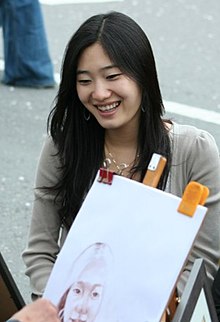
Back المرأة في كوريا الجنوبية Arabic দক্ষিণ কোৰিয়াৰ নাৰী Assamese Dones a Corea del Sud Catalan زنان در کره جنوبی Persian Wanita di Korea Selatan ID Condizione della donna in Corea del Sud Italian 대한민국의 여성 Korean Kababaihan sa Timog Korea Tagalog Güney Kore'de kadın Turkish
This article needs additional citations for verification. (March 2021) |
 A woman in Seoul, South Korea, 2007 | |
| General Statistics | |
|---|---|
| Women in parliament | 17% (2016)[1] |
| Women over 25 with secondary education | 79.4% (2010) |
| Women in labour force | 57.9% employment rate (2015)[2] |
| Gender Inequality Index[3] | |
| Value | 0.067 (2021) |
| Rank | 15th out of 191 |
| Global Gender Gap Index[4] | |
| Value | 0.689 (2022) |
| Rank | 99th out of 146 |
| Part of a series on |
| Women in society |
|---|
 |
Women in South Korea have experienced significant improvements for social changes in recent years, compared to previous times, when Confucianism was deeply imbued in the culture.[5] The economy of South Korea has tremendously improved due to urbanisation, industrialisation, military authoritarianism, democratic reform, and social liberalisation since the late 1960s. Gender roles and gender identities have been modified in response to modernity.[6] More than half of South Korean women are employed.[7] In a 2018 OECD economy survey, it was 56.1%. It is lower than OECD average. More than 25% of married women are employed as full-time workers.
In the South Korean political system, although there are not as many female politicians as male politicians, the female politicians have recently begun to participate more actively than in the past. For instance, in the National Assembly, women formerly occupied 20 of the 299 seats, less than 10%.[citation needed] After the 2020 parliamentary election, women occupied 57 seats in the National Assembly, or 19,1% (OECD), just above half of the OECD average (31%) (OECD) [8] the greatest number of seats occupied by women in South Korean history.[9]
The status of women varies depending on their social class and financial independence. In metropolitan areas, women have more access to education, which means they are less confined to the home as housewives. Most of the employed women in urban areas work in tertiary industries such as the service sector.[10][failed verification] In rural areas, most women work in a primary industry such as the agriculture sector. They do not have the variety of educational and employment opportunities. According to a 2019 survey by Ministry of Agriculture, 81% of respondents perceived female farmers to have lower social standing than their male counterparts despite accounting for over 50% of farmers in South Korea.[11]
The status of women has elevated but it still could not be seen as equal to men's social standing in terms of education, health, and legal rights. Moreover, there are still substantial political and economical prejudices against women.[12] Korean women still consistently face gender stereotypes regarding rigid gender roles. These stereotypes include women staying at home as housewives, having less power and voice in political and economic participation and movements, and more.[13]
- ^ "Women in Parliaments: World Classification". www.ipu.org. Archived from the original on 2014-03-28. Retrieved 2016-09-12.
- ^ OECD. "LFS by sex and age - indicators". Archived from the original on 2019-05-25. Retrieved 2015-11-30.
- ^ "Human Development Report 2021/2022" (PDF). HUMAN DEVELOPMENT REPORTS. Retrieved 18 October 2022.
- ^ "Global Gender Gap Report 2022" (PDF). World Economic Forum. Retrieved 24 February 2023.
- ^ South Korea Women in Culture, Business & Travel: A Profile of Korean Women in the Fabric of Society. World Trade Press. 2010. p. 1. ISBN 978-1-60780-256-3.
- ^ Kendall, Laurel (2002). Under Construction: The Gendering of Modernity, Class, and Consumption in the Republic of Korea. Honolulu: University of Hawaii Press. 2002. ISBN 9780824824884.
- ^ "OECD Economic Surveys: Korea 2018". www.oecd-ilibrary.org. Archived from the original on 2021-04-23. Retrieved 2021-04-29.
- ^ Lee, Young-Im. "Analysis | Five things to know about women and South Korea's 2020 elections". Washington Post. ISSN 0190-8286. Archived from the original on 2020-10-10. Retrieved 2021-04-26.
- ^ "여성의원 57명 역대 '최다 당선'...여전히 OECD 최하위권". BBC News 코리아 (in Korean). Archived from the original on 2021-04-26. Retrieved 2021-04-26.
- ^ "Home - ILOSTAT - The leading source of labour statistics". ILOSTAT. Archived from the original on 2021-04-28. Retrieved 2021-04-29.
- ^ 수정 2019.04.16 11:34, 입력 2019 04 16 11:00 (2019-04-16). ""여성 농업인이 52.7%인데 지위낮아"…농식품부, 여성농업인 전담팀 올해 상반기내 구성". JoongAng Ilbo (in Korean). Archived from the original on 2021-04-29. Retrieved 2021-04-29.
{{cite web}}: CS1 maint: numeric names: authors list (link) - ^ Chang, Pil-wha; Kim, Eun-Shil (2005). Women's Experiences and Feminist Practices in South Korea. South Korea: Ewha Womans University Press. ISBN 89-7300-638-X.
- ^ Cooke, Fang Lee (2010). "Women's participation in employment in Asia: a comparative analysis of China, India, Japan and South Korea". The International Journal of Human Resource Management. 21 (12): 2249–2270. doi:10.1080/09585192.2010.509627. S2CID 154442740.
© MMXXIII Rich X Search. We shall prevail. All rights reserved. Rich X Search